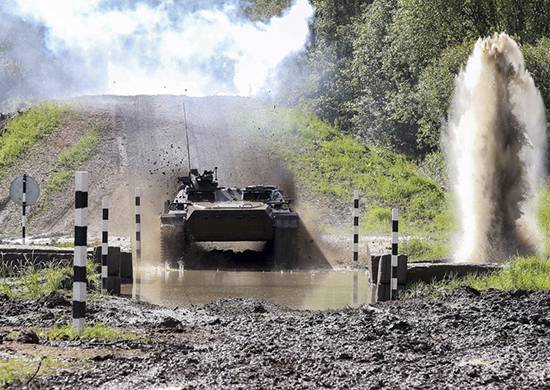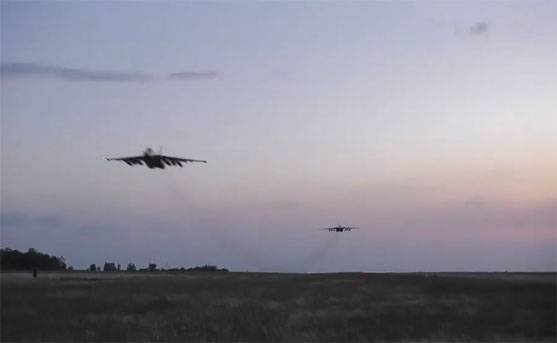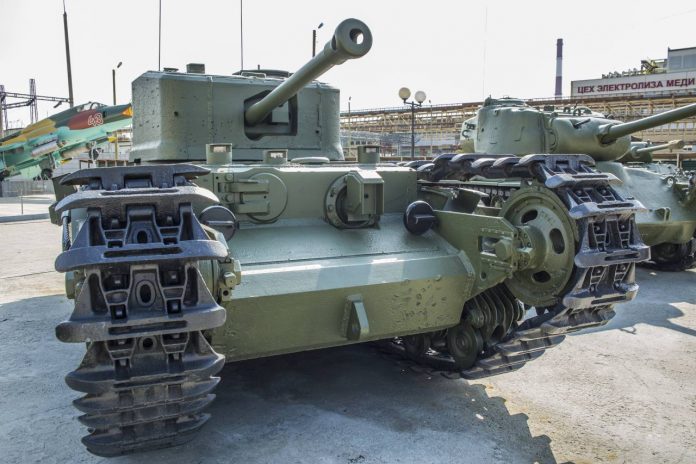
About today's hero of the story man, which is named in honor of the tank, He said: «The tank, wearing my name, More drawbacks, than I myself«. At least, many authors attribute this phrase is Sir Winston Leonard Churchill. Colonel of the British Army, British Prime Minister, writer and military journalist, Nobel Prize 1953 of the year.
Among the experts and fans of military equipment is still no consensus about this car. One side, we see a lot of obviously outdated, even archaic design decisions, On the other hand - the love of the Soviet tank precisely this heavy infantry tanks.
Many publications about military operations involving «Churchill» It referred to the fight, who led the team captain Belogub 22 Martha 1943 of the year. We had to find a description of the battle for, to find out, both proved to be exactly the tank.
To begin with - information, which will be a surprise for some readers. All Soviet tanks «Churchill» MK-IV (MK.IV - designation of tanks in various documents written in different ways) Guards were! unexpected fact, is not it? Meanwhile, it is true.
The thing is, that the heavy tanks of the Soviet and foreign production arrived on arms in separate Guards tank breakthrough regiments. Rank guard these shelves was obtained immediately after the formation of. Polk included 21 heavy tank and 214 personnel of the.
those machines, which after renovation fell into individual shelves or front-line army subordination still remained Guards.
First «Churchills» MK-IV took the battle of Stalingrad. Two guards tank breakthrough regiments, 47-th and 48 th, participated in the defeat encircled Paulus.
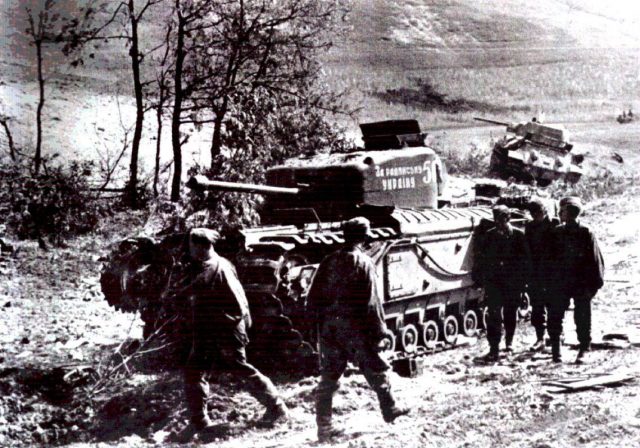
But back to the battle captain Belogub. 22 Martha 1943 of the year 5 tanks of the 50th separate guards tank breakthrough regiments «Churchill» MK-IV attacked the German positions. Tanks stormed the position, but the infantry was cut off by the Germans with artillery fire.
four cars, including the vehicle commander, were hit. The remaining tanks withdrew to the original, covering the retreating infantry.
The crews of the wrecked tanks decide to continue the fight in the damaged car. Good, tank ammunition allows you to do it. Battle under fire of German artillery. Marines at night brought the tanks of ammunition and food.
25 March to the tanks managed to get a tractor. Tank commander picked up in tow. Crews of other tanks left the car and departed with the infantry. The result - no victim tankman! armor «Churchill» I stood still!
Very often even experts underestimate this car. many drawbacks, which protrude and dignity in every way, which prefer to ignore. Somehow, implanted opinion, that the British sacrificed everything, for the sake of enhanced reservation.
But the Red Army at that time few believed the word. trust, but verify. especially if, when it came to military equipment. This check has passed and «Churchill». And, British tank was evaluated in comparison with the Soviet KV-1 and KB-1C. An excerpt from an article by Michael Bariatinskii «infantry tank «Churchill».
so, «Report on a short-term test of the English heavy tank MK-IV «Churchill» on NIIBT Polygon GABTU Red Army», from 16 September 1942 of the year.
According to this report, our specialists have identified shortcomings and the positive qualities of the machine. Point by point the conclusions analyze below. And here general conclusion about the suitability of the machine to the statement on the arms of the USSR Army give full:
«English heavy tank MK-IV «Churchill» in its armament, armor protection and maneuverability can deal effectively with the tanks of the German Army.
In this type of tank MK-IV is not carried through the machine in a constructive, and in terms of production. During operation in units Tank MK-IV will require frequent repairs with replacement of individual parts and whole units.
The individual units of the tank (turning mechanism in one unit with the transmission; and others.) They are the original structure and can be recommended for introduction into domestic tank building«.
Here it is necessary to make a slight digression from the story. Conclusion The Commission is given for a specific tank-MK-IV. A modification in «Churchill» It was 11! In the USSR, these machines were not delivered, so, to save time, discussion materials on this topic carried forward.
Consider the car closer. Let's start with the hull. Especially, that the body is really interesting and construction, and execution.
body frame «Churchill» It is going from the corners of the rectangular box! Further, on the frame by means of rivets fastened conventional steel sheets. And the resulting weight wrong body armor steel. Who out there claim to the invention of "Lego"?
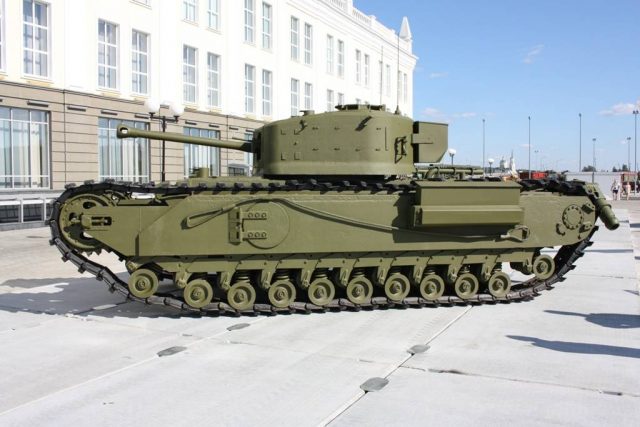
The withdrawal of Soviet engineers: «Tank MK-IV gives the tanks 1 and KB-KB- 1With power on gun arms, but it has the advantage of armor protection«. It would be really strange not to recognize the advantage of booking on the ratio of the thickness of armor 152-77 mm for MK-IV, 95-75 mm for HF-1 and 82-60 mm KV-1C.
To facilitate the arrangement within the machine components and assemblies, as well as weapons and crew, The body is made as wide as possible. For this it was necessary to return to the layout, that was used for another of the first tank.
The design solution is, to hide under the chassis of the machine housing. engineers «Vauxhall Motors» successfully accomplished this task. The tank was simply smart power pack. And the positioning arms could somehow.
Solved was one more task, which always put the tank crews designers, but rarely performed. Tanks «Churchill» We got a side door on the driver's compartment the level of crew evacuation!
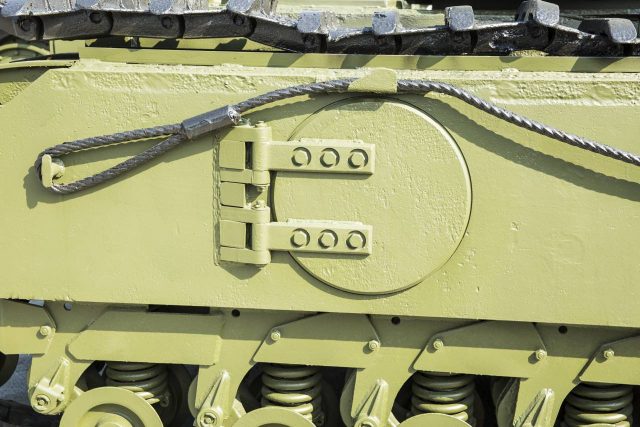
We consider it necessary to clarify some of the details, which cause disputes. Namely, the length and width of the hull «Churchill». Dimensions are not defined by the whim of the designers, and technical tasks and operating conditions of the tank.
Let's start with the car length. To explain this phenomenon is enough to remember the purpose of the machine. Heavy Infantry Tank. I.e, tank, designed to penetrate enemy fortification structures and provide an offensive infantry.
And what are the main types of structures used? Trenches and antitank ditches. An elongated body made it possible to overcome the wide ditches, which according to field manuals of their armies will be equipped with the enemy positions.
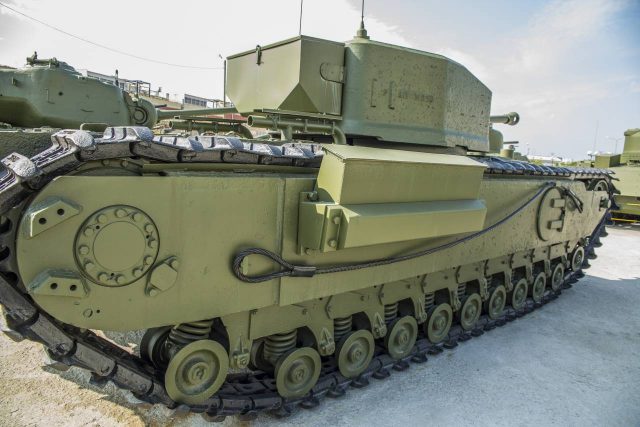
The narrowness of the body, too, is easily explained. The tank is designed to combat. And he did not have to do marches on 500-600 km. For this there is the railway transportation. So all too easy, width «Churchill» It corresponds to the width w / e platform in the UK.
Evaluation of our engineers in the body of the tank:
«Body armor is somewhat unusual and extended, respectively, reduced in width and height. The bow of the hull was rising high drop-bed between tracks, are covered with large sumps. This creates poor visibility for the driver and gunner. Periscope vision devices, installed around the driver and arrow, increase the visibility of small.
At the position downstream of the tank cannon, bleed bore does not exceed the dimensions of mud and in between. This leads to, that is fired from the gun in a position of the gas wave front breaks and tears the sumps of the tank«.
Looking ahead, note, that the same is due to a small maximum speed of the machine - 28,1 kmh (KB-1 - 35, KB-1C - 43 kmh) at approximately the same speed on the highway (MK-IV - 25,4, KB-1 - 24, KB-1C - 22 kmh) and the lane (respectively 17,5, 18 and 16 kmh).
No less interesting and the tower «Churchills». The towers were three types. Cast, welded and combined. MK-III were welded tower, and MK-IV - cast.
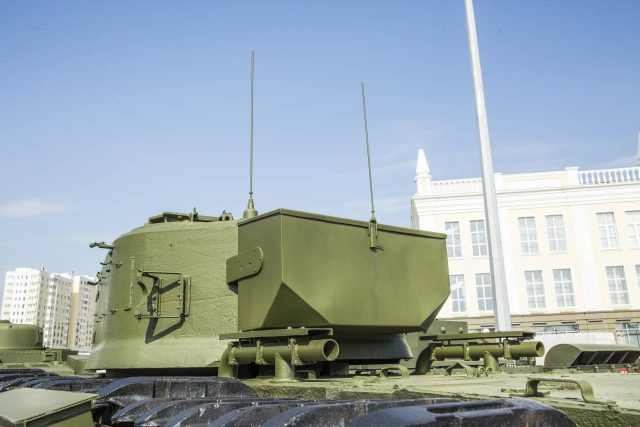
Besides, tower maintaining internal identity by location units, observation devices, weapons and even manholes and hatches were some differences in appearance and size.
The power plant at all «Churchill» the same. 12-cylinder, Carburetor horizontally opposed engine liquid cooling Bedford «Twin-Six» capacity 350 HP. at 2200 rev / min. working volume 21 237 cc.
Every three cylinder motor had its own carburetor. Total - four brand carburetor Solex 46FWHE.
Evaluation of our engineers such:
«Tank Engine is quite modern construction of Automobile and Tractor type. The engine design is executed with minimal application vysokodefitsitnyh non-ferrous metals and is designed for mass production. Along with these advantages tank engine MK-IV is not brought up to the end of the structure, and therefore the reliability of its operation should be questioned«.
The fuel is stored in seven tanks. six core, located on either side of the engine on the three tanks. Reserve tank externally located on the housing, but I had a connection to the fuel system of the machine. Capacity of tanks 828 liters.
The cooling system has two radiator, located on both sides of the engine. system capacity 118 liters.
Lubrication systems circulation, dry sump. With two pumps - pumping and suction. The total capacity of the lubrication system - 50 liters.
British engineers have taken care of, to keep the crew in the defeat of the tank to the engine. Engine-transmission compartment was separated from the steel armor from the crew compartment by a partition. In the case of, when he smote the fighting compartment, engine and transmission remain intact.
Quite interesting and chassis tank. Caterpillars were of two kinds. or width 356 mm and a step 211 mm (70 Trakov), either with the same width, but step 202 mm (72 tracks).
On each side there 11 twin rollers of small diameter. Suspension of the individual spring.
Interestingly, that the support rollers on the machine was not. Caterpillars slipped on special guides, as it was the first tank.
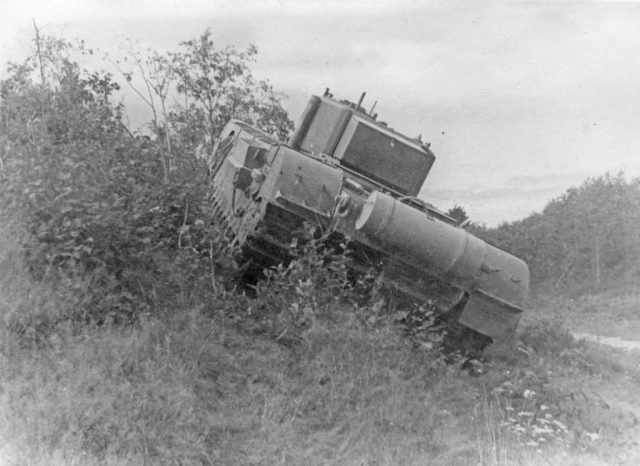
Generally, undercarriage was extremely unfortunate. Especially in combination with the length of the hull. The tank could not overcome even small rises. Even savvy Russian, when specialists have built up one of the regiments of the lugs, little help.
But even more dangerous was the ride on the slopes. Even when driving with a roll of less 20 degrees, tank tracks often dropped. at 20 degrees and a loss of caterpillars was the norm. That in conditions of Russia was a big problem.
Evaluation of our engineers on the chassis:
«Chassis was not strong enough for the 40-ton tank. As shown by the short-term test, axles bogies with fly off welding internal support rollers, thereupon lost external support rollers with axes, trolleys balancers start to rub against the caterpillar and quickly fail.
Road wheels of trucks in its flanged spacers adjacent to the tracks of a caterpillar, why the rollers and tracks have increased wear. Rollers while driving very hot, which is associated with an increased friction rollers of the caterpillar. Fingers caterpillars have insufficient mechanical strength and break«.
So many questions is the presence of two antennas. The explanation of this phenomenon is simple. «Churchills» They were equipped simplex radio telephone and telegraph № 19, that was able to operate in two bands - HF and VHF. It also provides internal communication and five crew members.
To work each band requires its own antenna. In this way, HF antenna connection provided at a distance 15 km. When CW - up 32 km. A VHF antenna provides telephone service at a distance of up to one kilometer.
Naturally, communications required an additional charge unit. The MK-IV, he was. This single-cylinder petrol engine with a generator. This unit allows you to charge the battery in during any stoppage.
We purposely left the story of the arms at the end part of the tank design. The thing is, that arming these machines, even one modification, It can be very different. It all depends on the specific destination of the tank.
First of all it is necessary to explain the inaccuracy, which allow for many, telling about the first versions «Churchill». These machines have never had two guns like American M3 «Lee» or «Grant».
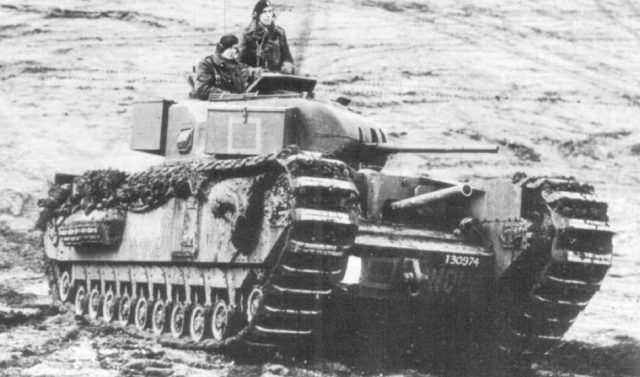
What, then, in the photo? How do you know that there are two trunks?
Earlier we wrote about the original purpose of this tank. Heavy Infantry Tank. Fight with enemy tanks on modern warfare tactics was the task of artillery.
Yes and 40 mm (two pound for British classification) Gun Mk IX in the tower provides the necessary power of the machine antitank defense. Her armor was sufficient at the time.
weapon, which is set in "Churchill's" body was howitzer! more precisely, tankovaya howitzer 3″ Howitzer OQF Mk I or caliber Mk IA 76 mm. And howitzer designed exactly for the same, what meant all the guns of this type.
We are interested in machines, who came to the USSR in Lend-Lease. This two tanks modifications and MK-III MK-IV. Tanks are virtually identical, except tower. MK-III had welded tower, and MK-IV cast.
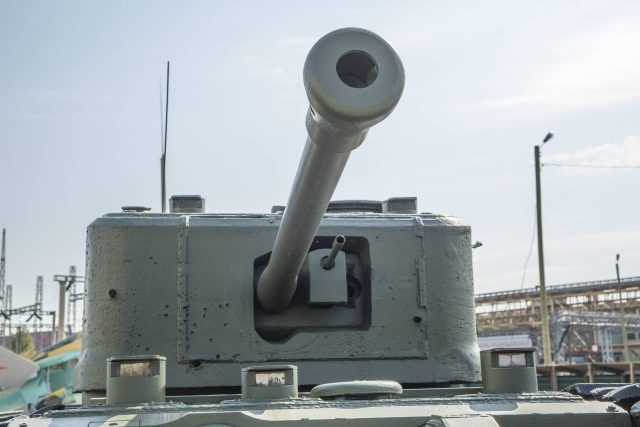
tank armament was also different. Tanks are usually equipped with a series of 57-mm (6-British pound on classification) guns Mk-III. by the way, it is this machine was tested on NIIBT Polygon GABTU Red Army, which we wrote above.
However, in the Soviet Union tanks are supplied with guns Mk-V (75-mm), with a barrel 36,5 caliber. The gun has a semi-wedge bolt. Skorostrelnost- up 20 rounds per minute.
Vertical guidance from- 12,5° to + 20 ° with the lifting screw type mechanism. Electric trigger - foot. Ammunition models of tanks VII and X consisted of 84 shots.
The tank had two 7.92 mm machine guns armed Besa. Let not such a strange surprise for Britain caliber, instead of 7.69 mm, here at the heart of the Czech machine gun with a caliber of German. One gun was ESP, with elevation angle +17 degrees and declination -8 degrees. The second gun was paired with a weapon. ammunition was 4950 rounds.
And again output Soviet Engineers MK-IV:
«Ammunition for machinegun armament MK-IV has three times as many, compared with KV. Armor-piercing grenade 57mm cannon, mounted on the MK-IV tank, pierces the armor of the two sides of the German medium tank T-III in a total distance of 60mm with a thickness 950 m«.
On some machines, it was possible to install anti-aircraft guns. more precisely, on spacers installed antiaircraft Lakeman for 7.7-mm infantry gun Vgep. Ammunition of this gun was 594 cartridge.
IN «Churchills» and it has another feature. On the turret is 50.8 mm (2 inch) mortar! In the original version it is intended for installation of smoke screens. weight mortar 7,6 kg. Staff BC - 30 flue min. Range of fire smoke mines - 137 m.
Soviet tank crews quickly realized, that smoke mines to break the tank is not very relevant. But also «idle» mortar on a luxury War. Soldier savvy worked quickly (the invention of the author, we could not find).
In our army used 50-mm mortar company commander. Mines of this particular mortar and steel additional weapons «Churchills». Furthermore, fragmentation mines were flying on flue - 415 m. Vertical firing angle - from + 5 ° to + 37 °; horizontal - 360 °!
Sights for the British, too, were his. Sight used for coaxial machine gun and № 50x3L Mk I. For a course of gun used telescopic sight number 30 Mk I.
And machine, that you see in photos, One of the modifications «Churchill». To be precise, the, what you see, is an «Churchill Crocodile». «Crocodile» in the title has nothing to do with water. Making swim 40-ton machine is difficult.
"Crocodile" - flamethrower tank based MK-IV. In other museums you can see the "Crocodile" later modifications - MK-VII.
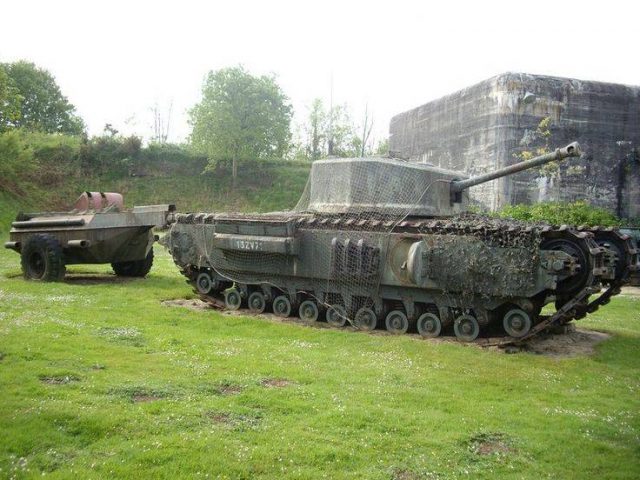
so, flamethrower tank design. This second embodiment of such a construction. The first embodiment was using «Churchill» II. The car was named «Churchill instructs wrestlers at Oak». He used the company's flame-thrower «Ronson».
Ognesmesi tank installed on the aft of the tank. Along the left side paved the hose and connect it to the hose from, which is installed between the front protrusions crawler bypass. The mixture was supplied via a pneumatic system using nitrogen pressure.
Alas, but the data flamethrower tanks not even reached the battlefield during the landing at Dieppe. They were destroyed. And the very idea of such a flamethrower tank became unpopular. Getting into the tank from the tank ognesmesi made a huge torch.
But soon there was a second version of the flamethrower. Now ognesmes not located on the tank, and transported in a special armored tank. The principle of operation is the same, as before. The machine was put into service in 1943 year.
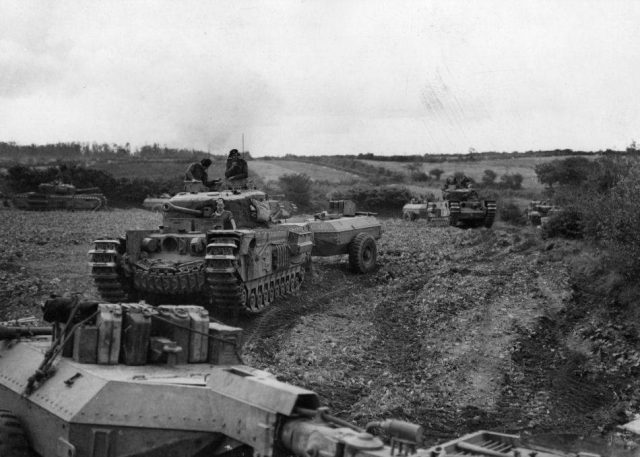
The trolley was connected to the tank through a special nozzle, and then walked down the tunnel ognesmes, laid under the armor. A much more practical option, armor still need to break through.
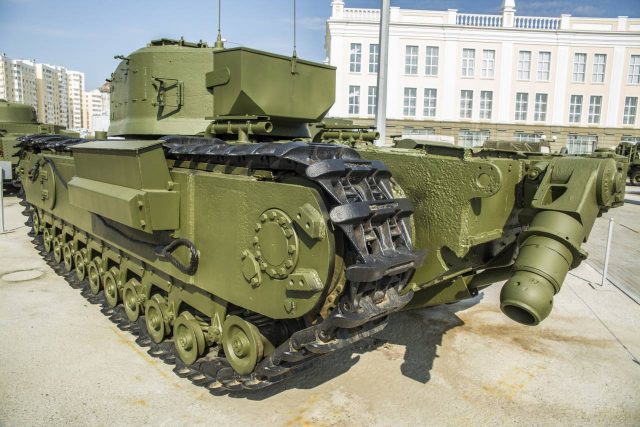
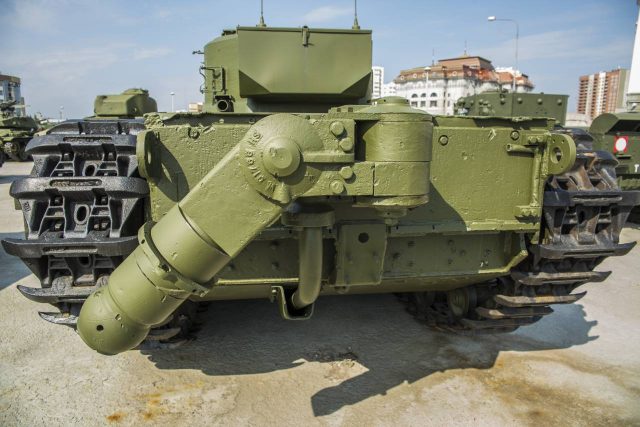
spit fire «Crocodile» I could have 120-140 m.
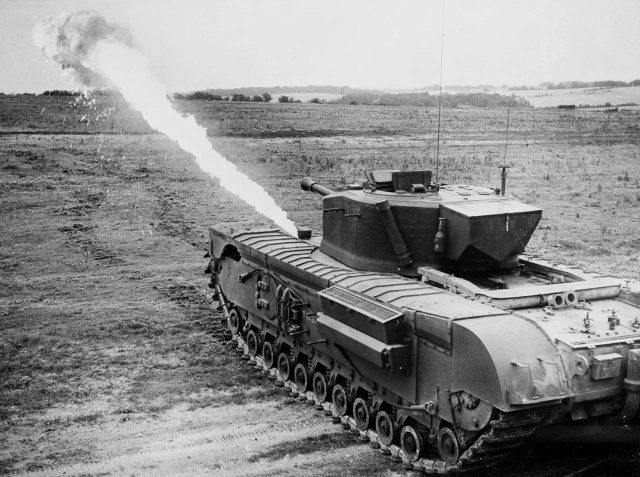
Here, by the way, the tower is clearly visible mortar tube.
Altogether during the war has been released 5 460 units «Churchills» all modifications. Of them in the Soviet Union fell 301 unit.
And despite the rather modest number of these tanks in the Great Patriotic fields, machine lit up in many iconic battles.
Some of the episodes we recall. The liberation of Kiev 6 November 1943 he took part already mentioned our 48th Separate Guards Tank Regiment.
The Battle of Kursk distinguished two Guards regiments breakthrough as part of the 5th Panzer Army, 15 th and 36 th. At the end of the battle regiments reformed. 15-d already equipped with Soviet KV-1C. Both deployed near Leningrad.
There's also fought against the fascists of the 49th and 36th regiments breakthrough. We fought until the liberation of the city. 50-first breakthrough regiment was part of the Volkhov Front.
82-nd independent regiment participated in the liberation not only of Leningrad, but also in Tallinn and even Moozundskih Islands. 21-th separate Guards regiment breakthrough first broke in Vyborg.
Today it is possible to compare the long and dreary, as he was bad or good "Churchill" in comparison with HF.
If you look very carefully, in terms of armor, weapons, functionality, "Churchill" is not inferior, and in many respects even surpassed the domestic heavy machinery. If he learned to ride - the price would be the Briton was not.
Unfortunately, thick armor and a good gun (and gun "Churchill" "took" in the side of the Germans, including "Tiger" with distance 800-1000 meters without any problems) - it is not important in the fight. Speed and patency - an important component for the tank, in addition to the above.
So that collectively the "Churchill" is still losing our HF, anyway.
TTX tank MK-IV «Churchill Crocodile" from the collection of UMMC military equipment museum in Upper Pyshma:
combat weight, t: 40
Dimensions, mm:
- length: 7440
- width: 3250
- height: 2490
- clearance: 530
weaponry:
- 75 mm cannon, ammunition 48 shells;
- machine gun 7.92 mm;
— огнемет «Ronson», firing range of up to 140 m, b / c 1818 l.
booking, mm:
- forehead housing: 152
- side of the hull: 76
- tower: 95
Engine: 12 horizontally opposed-cylinder liquid-cooled Carburetor «Bedford» «Twin Six».
Power, hp: 350.
full speed, kmh: 28/20 (with trailer).
Power reserve, km: 245.
Crew, people: 5.
/Alexander Staver, Roman Skomorokhov, topwar.ru/








